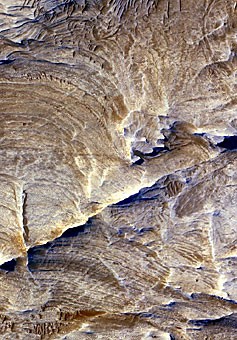Recent photographs of Mars transmitted by the UA-operated High Resolution Imaging Science Experiment camera show evidence that liquid once flowed underneath the surface of the red planet.
Two UA scientists, Alfred McEwen, a professor of planetary sciences, and Chris Okubo, a research associate for Lunar and Planetary Sciences Laboratory, have examined the photographs of the rocks found near the Candor Chasma, near the equator of Mars, and found evidence that water flowed under the Martian surface millions of years ago. The results were published Feb. 16 in the journal Science.
The area featured in the photograph, taken in October, showed borders of light-colored rock along fracture lines. The two scientists interpreted these areas of light coloration to be areas where chemical bleaching has occurred, Okubo said.
“”In order for the bleaching to occur, you need some sort of liquid to bring the chemicals into contact with the rock,”” Okubo said. “”The most common fluid would be water.””
What makes these photographs significant in the study of water and life on Mars is the length of time needed for a rock to be bleached and where the water flowed, Okubo said.
The bleaching process is slow. Therefore, the liquid that flowed through the fractures must have been flowing for several years to bleach the surrounding areas.
“”This tells us that the conditions on Mars, at least back then, could have been very similar to conditions on the Earth.””
– Bruce Bannerdt
project scientist for he Mars
exploration rovers at the Jet
Propulsion Laboratory
Additionally, the water flowed underground, which provides a more sheltered environment than the surface.
Further chemical analysis needs to be conducted to determine exactly what flowed through the fractures.
“”We know that Mars is a water-rich planet,”” McEwen said. “”It’s very likely to be water.””
While Mars is known to be home to water in both solid and vapor forms, water in liquid form is unstable on the surface of the planet due to pressure and temperature.
But conditions on Mars some time in the past when the bleaching of the rocks occurred supported liquid water, said Bruce Bannerdt, project scientist for the Mars exploration rovers at the Jet Propulsion Laboratory in Pasadena, Calif.
“”This tells us that the conditions on Mars, at least back then, could have been very similar to conditions on the Earth,”” Bannerdt said. “”If conditions are similar, it’s at least plausible that life could have been present on Mars.””
Areas where groundwater might have flowed are estimated to cover about 10 percent of the surface of Mars, McEwen said.
The evidence of past water flow provides clues to what areas might be best to study on Mars.
“”This is a place where fluid flow has been concentrated. These are the places we want to go on the ground with rovers or with people,”” McEwen said.
Two rovers are already looking for evidence of water on the surface of Mars. The rovers, named Spirit and Opportunity, landed on the planet’s surface and examining the geology of the surface for evidence of water in the past.
The chemical composition of rocks is being examined as well as the manner in which they were formed. One key finding of the rovers that has led scientists to believe water flowed on Mars is layered rocks, Bannerdt said.
“”They found certain rocks that can only form in the presence of water,”” Bannerdt said, referring to the layering and shaping of the rocks.
In addition to the missions already exploring Mars, two future missions are planned to further explore the presence of water on Mars and the past habitability of the planet.
The Mars Science Laboratory, due to launch in fall 2009, is operated by NASA and the Jet Propulsion Laboratory. The MSL is a large rover that will be looking for chemical evidence for life on Mars, Bannerdt said.
The Phoenix mission, due to launch in August, is operated by NASA and the UA’s Lunar and Planetary Sciences Laboratory.
The Phoenix mission is a stationary lander that will examine ice deposits in the northern polar region looking for chemical evidence of life.
“”Instead of just looking for bugs in the dirt, we are now doing a systematic search of the environment, and by understanding the environment we hope to come up with a more robust search for life,”” Bannerdt said.









